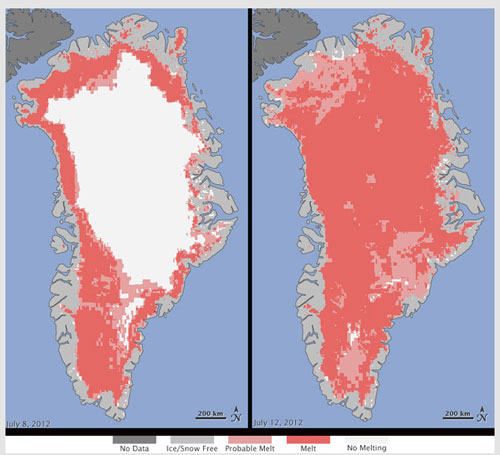Nick Mirzoeff and Bill DiFazio wrote about Morning In America which was published in an 8-page newspaper handed out to visitors at the installation sites in Tampa and Charlotte.
Disappearing Like Ice
Nick Mirzoeff
Artists Ligorano and Reese have made a new ice sculpture called Morning In America to confront delegates at the Democratic and Republican conventions. About 2000 pounds of ice will be carved to read: MIDDLE CLASS. Over the course of the next twenty-four hours, the sculpture will melt away, leaving only memories. It’s a combination of earth, language and performance art, creating a striking hybrid. For whereas land and environmental art has tended to create permanent forms out of rock, earth and water, this piece is time-based, like performance. In the tradition of language work, it relies for its impact on the material form of language but here the words are transitory and ephemeral, like conversation rather than print.
One of the oddities of the United States to an outsider is the insistence that there is no such thing as class here, only a “middle class” that covers almost everyone. Any attempt to point out that government policy over the past three decades has enormously benefited the wealthiest, those now known as the one percent, is nonetheless immediately described as class war.
There is a way to make sense of the “middle class.” We might describe it as the assemblage of all those people able to improve their lives by debt financing. That would extend from the lowly store credit card via student loans to the mortgages that made the “American dream” of home ownership possible. Excluded from the debt middle class would be those at the bottom unable to qualify for credit, except at places like Pay Day loan sharks or pawn shops. At the top, there are those who use debt to make more money, whose personal well-being is not at risk.
As we all know, this middle class is indeed in dire danger. Student loans now total an absurd $1 trillion, while outstanding credit card debt is not far behind at $800 billion. As secured loans, mortgages were supposed to be the smartest investment a person could make. Today, some ten million homes have been foreclosed or are in the process of foreclosure. So what would be left of “America” if the middle class disappeared, as Ligorano and Reese suggest? The melting will leave us drowning in debt.

Map of Ice Melt in Greenland 2012
Melting ice is of course also suggestive of the palpably accelerated pace of human-caused climate change. This Northern summer has seen unprecedented ice melt across the Arctic and Greenland, prompting only an unsightly squabble among nation states as to who gets the mineral rights to the newly exposed land and sea bed. Neither political party has anything of substance to say about the planetary disaster, for fear of alienating Big Oil. Perhaps the very melting of the art work recognizes that its message will not be seen, let alone heard.
Let’s propose an alternative ending: the melted water should be collected, refrozen and carved to read: We Are The 99%. S17. Join us.
Nicholas Mirzoeff is Professor of Department of Media, Culture and Communication at NYU and is active in the Strike Dept. Campaign of Occupy Wall Street. He writes everyday about the Occupy movement at www.nicholasmirzoeff.com/O2012
The Jobless Middle Class Is Melting
Bill DiFazio
Global capitalism’s current failures were started by a mortgage crisis and new investment innovations, such as derivatives and credit default swaps. The recent LIBOR (London InterBank Offered Rate) scandal has added to that economic disaster without a seeming solution. Governments have bailed out financial institutions and corporations but have left middle class people with libertarianism, which is just another way to say without any help. We have socialism for the rich through stimulus packages and extreme tax cuts, while the middle class has to suffer with free market capitalism.
The supposed booms of the 1990’s and 2000’s were not for everyone. They were followed by financial crisis. Increased debt and job loss were the real motors of the boom. Many middle class people were told by the banks that personal debt wasn’t a problem and in turn used their home mortgages as assets to pay for their “affluence” in the absence of wage and salary increases. It seemed like everyone was rich but, in reality, everyone was in massive debt; only the rich were getting richer from the debt of ordinary people.
Consumption was the real freedom of being an American. If you had the money, you could buy anything and endless debt meant that you had the money. The great recession brought the country back to earth. Overpriced houses were foreclosed, more jobs were lost, wages and benefits fell, and credit ended – the myth of the new economy, where growth had no end, was finally exposed. Even the hedge funds armed with fictitious capital would be soon marooned on the rocks of an economy in which all boats didn’t float.
After all, to make a profit, capitalism must always reduce costs and the most expensive costs are always middle class jobs at good wages. New computer-aided global capitalism replaced workers with machines at hyper-speed. The world cannot produce middle class jobs and these jobs are now lost forever. At this point in our history only an upper class elite is engaged in successful class warfare. The middle class is doomed unless they wake-up and begin to struggle for their own interests.
William DiFazio, the author of Ordinary Poverty and The Jobless Future, Second Edition. Host of CityWatch, WBAI, 99.5FM in New York City.